Gone But Not Fogotten - Honouring the Life and Afterlife of one Irish-Speaking Emigrant
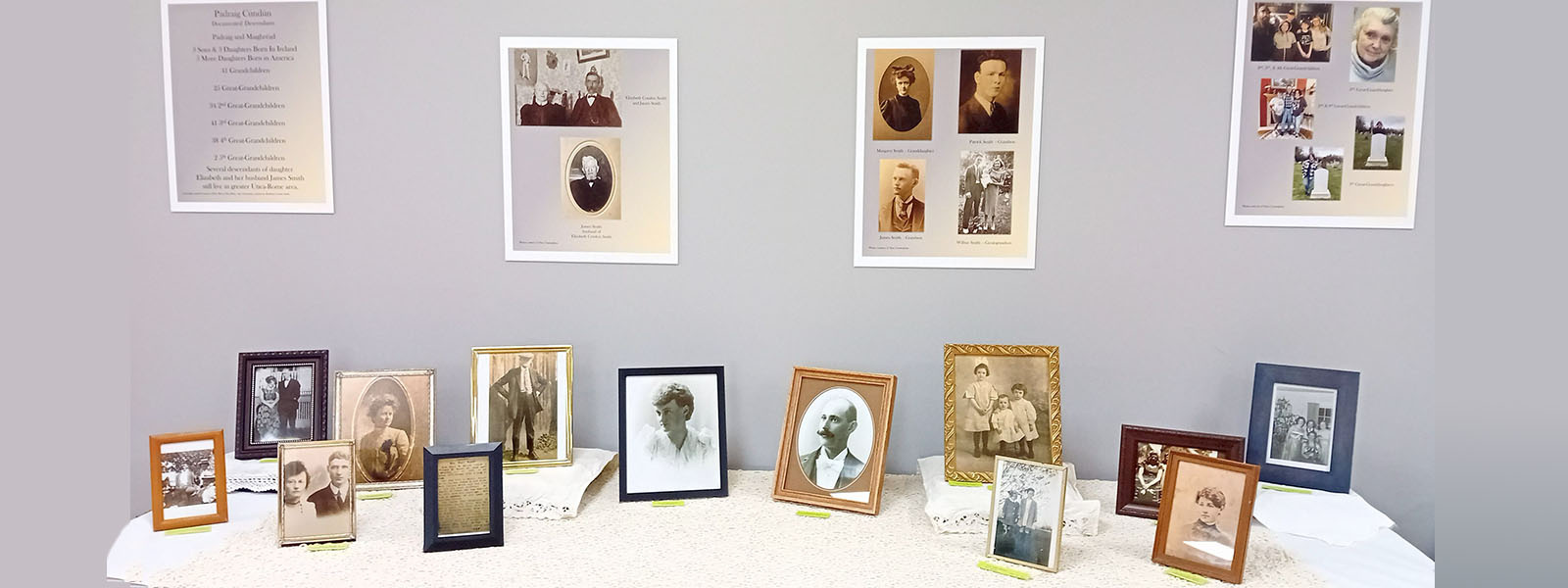
Some of the photos of Padraig Phiarais' descendants on display as part of the exhibition at the Irish Cultural Center.
During the summer 2025, Dr Tony Ó Floinn of Roinn na Gaeilge travelled to the United States to unveil a plaque in honour of Pádraig Phiarais Cúndún (1777-1857) - one of the most significant figures in the history of Irish language and literature in North America.
In 2026 it will be two hundred years since Pádraig Phiarais Cúndún, a tenant farmer, departed from Cóbh to sail to Quebec and settle in Deerfield, Utica in New York State. Given that an estimated one million Irish people emigrated to North America between 1800 and the start of the Great Famine, this action can hardly be considered unique in itself. Doing so at almost 50 years of age and with a young family, might not have been typical of most emigrants, but it was well within established transatlantic emigration patterns of the eighteenth and early nineteenth century. However, being a monolingual speaker of Irish was more uncommon among the emigrants to North America of that period. Pádraig Phiarais had learned to read and write Irish as a young man, an ability relatively rare among native speakers of Irish – most of those who could read and write could do so in English only.
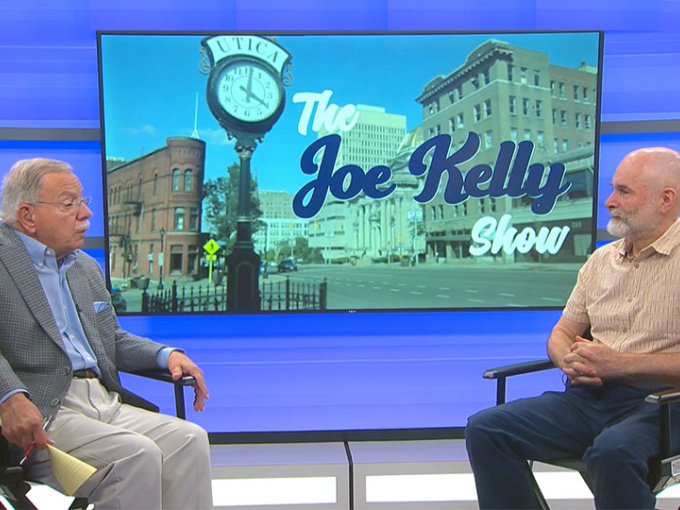 Tony Ó Floinn being interviewed by Joe Kelly on the local tv station WUTR during his visit to Utica.
Tony Ó Floinn being interviewed by Joe Kelly on the local tv station WUTR during his visit to Utica.
One consequence of this was that Irish speaking emigrants tended to write letters home in English even if the recipient back in Ireland could not read English. And those emigrants who could not read or write English sought the help of those who could. This has resulted in the almost complete dearth of writings in Irish from North America in the first half of the nineteenth century and during the Famine. The importance of Pádraig Phiarais lies in the fact that he refused to conform to these practices and wrote letters and poems in Irish for over two decades in his adpoted home; most of these were sent home to friends and neighbours in his native Ballymacoda near Youghal in east Cork. Those which survive now comprise the largest corpus by far of the Irish language in North America from this period. Hope remains that writings of others will still come to light and indeed, more of Pádraig Phiarais’ own writings.
While the location of Pádraig Phiarais’ grave was long known in Ireland, local memory of Pádraig Phairais in Utica had faded until supporters of the Irish Cultural Center of the Mohawk Valley in Utica became aware of him in the early 2020s. One of their first actions was to restand his headstone and have it cleaned.
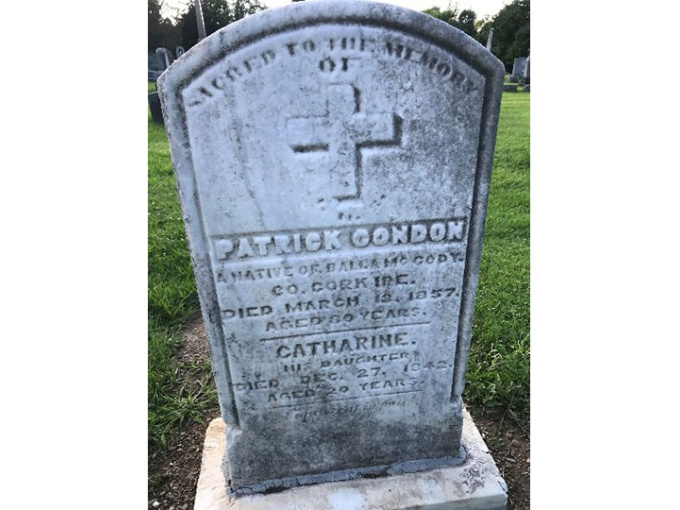 Partially cleaned headstone in early summer 2021 (photo courtesey of Mike Hoke, Irish Cultural Center of the Mohawk Valley).
Partially cleaned headstone in early summer 2021 (photo courtesey of Mike Hoke, Irish Cultural Center of the Mohawk Valley).
In November 2022, Dr Ó Floinn gave an online talk on Pádraig Phiarais Cúndún to the Irish Cultural Center of the Mohawk Valley in Utica. Shortly afterwards, a Patrick Condon Group was formed under the aegis of the Center with aims of researching his life in Utica, attempting to locate descendants and raising awareness within the Irish-American and wider community. Dr Ó Floinn was delighted to be invited to participate. An early milestone was identifying the location of his farm in Deerfield which had been lost to memory. The group put an impressive amount of painstaking work into trying to find out what happened to his children and their descendants, a process hugely complicated by the presence of four of Padraig Phiarais’ first cousins in the vicinty of Utica with much crossover of names. While these achievements were satisfying, the most exciting discovery was locating living descendants of Pádraig Phiarais, some of whom live locally, but all of whom were completely unaware of their highly regarded ancestor.
In early 2025, the Patrick Condon Group decided that the time had come to share their research with the public and to erect a permanent physical marker to commemorate Pádraig Phiarais as the existing inscription on his headstone was completely in English and gave no hint of his literary activites. Dr Ó Floinn was honoured to be invited to unveil the bronze plaque on Pádraig Phiarais’ grave.
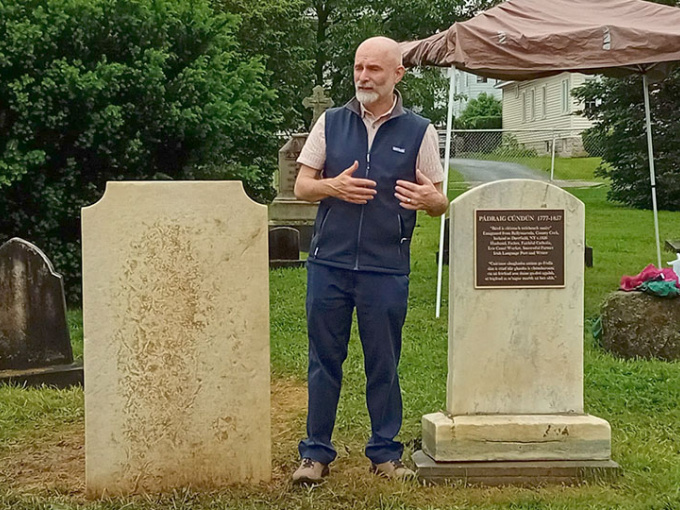 Tony Ó Floinn speaking after unveiling the plaque (to his left).
Tony Ó Floinn speaking after unveiling the plaque (to his left).
Dr Ó Floinn and his wife Sheila Dillon were also honoured to be invited to attend the opening of the first ever public exhibition on Pádraig Phiarais Cúndún in the Irish Cultural Center. Dr Ó Floinn had the opportunity to address the gathering and to present a copy of The Atlas of the Irish Famine to the Center in recognition of their groundbreaking work on Pádraig Phiarais and as an acknowledgement of their warm hospitality and generosity in hosting his and Sheila’s visit.
Undoubtedly, another highlight was meeting some of Padraig Phiarais’ relatives, an occasion which was merely a pipe dream when Dr Ó Floinn embarked on his doctoral research on Pádraig Phiarais as far back as 2012. Their interest in Pádraig Phiarais was palpable and while the youngest generation present may not remember the events in detail, it is evident that their grandparents and parents will pass this rich aspect of their heritage on to them.
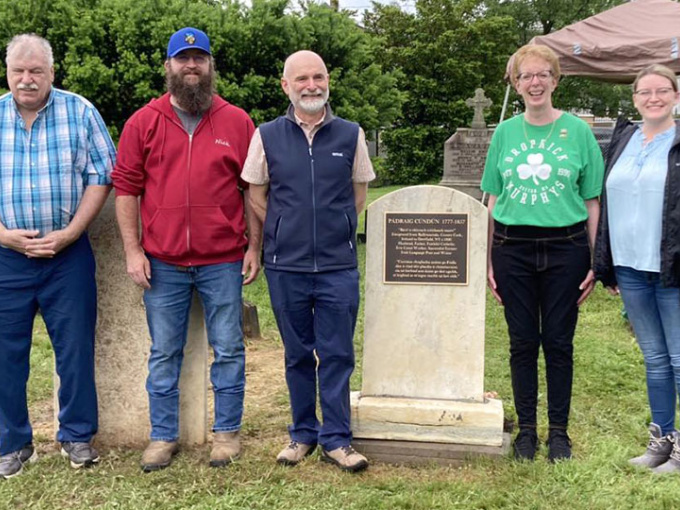
Patrick (Rick) Smith, great-great-grandson of Pádraig Phiarais; Nick Smith (Rick's son); Tony Ó Floinn; Vanessa Kauth Graham, great-great-great-granddaughter of Pádraig Phiarais; Laura Smith (Rick's daughter). Photo courtesy of Chris Hoke.
Dr Ó Floinn also had the opportunity to visit site of Pádraig Phiarais’ small farm in Deerfield, a few miles from the town. No traces of the original buildings, almost certainly wooden, remain; forest still bounds some of the land and can be seen in all directions as is typical in upstate New York.
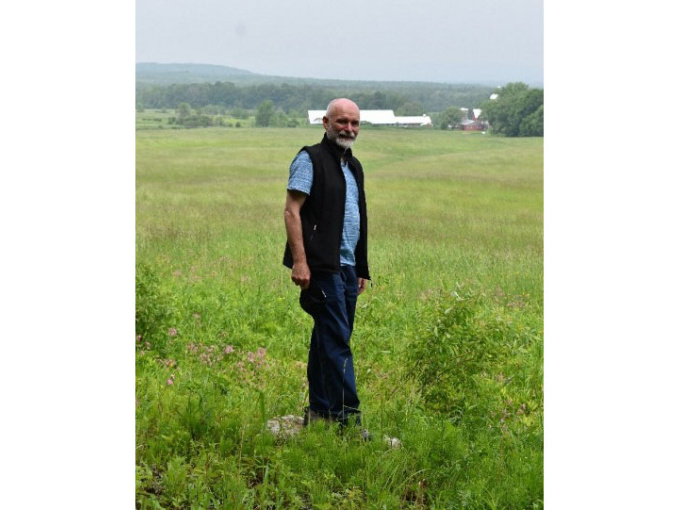 Tony Ó Floinn on the land purchased by Pádraig Cúndún over a seven year period from 1827-1834. It is still farmed but not by descendants of his.
Tony Ó Floinn on the land purchased by Pádraig Cúndún over a seven year period from 1827-1834. It is still farmed but not by descendants of his.
Buoyed by the success of these events, the Patrick Condon Group has continued its work. One ongoing project is the grave of Maighréad Nic Cárthaigh, Pádraig Phiarais’ wife. Her grave had been marked by what appeared to be an inscribed stone slab but investigation revealed it to be a fallen headstone. The group had it erected prior to the plaque unveiling and the slow process of cleaning it without causing damage has commenced. The search for further living descendants in the United States continues while the group is also reflecting on the possibility of finding relatives of Maighréad and Pádraig Phiarais in Ireland.
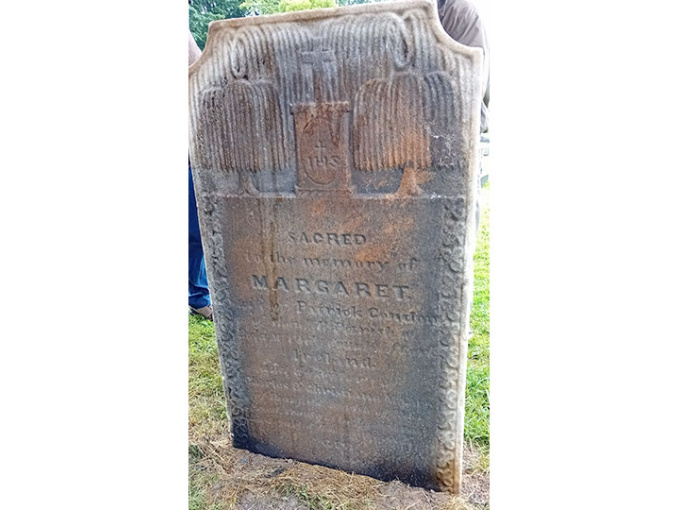 Grave of Maighréad Nic Cárthaigh, Pádraig Phiarais’ wife.
Grave of Maighréad Nic Cárthaigh, Pádraig Phiarais’ wife.
Note: The television interview with Joe Kelly cannot be accessed from this side of the Atlantic but please contact Tony Ó Floinn at Tony.OFloinn@mic.ul.ie should you wish to view it.
Many people have contributed to the work of the Patrick Condon Group in the Irish Cultural Center of the Mohawk Valley. Chris and Mike Hoke have been to the fore in setting up the group, doing much of the core work and encouraging others. Jerry Reed conducted the breakthrough genealogical work from which benefits continue to flow. Colleen Martin, Mary McGuirl and Steven Griffin have worked steadfastly in progressing multiple strands of the group’s work. Valuable support has also come from Al Sisti and Joe Kelly. It has also been a pleasure to welcome descendants of Pádraig Phiarais himself to the group: Patrick (Rick) Smith, Nick Smith, Laura Smith, Nina Smith Cunningham, Lori Smith Stewart and Vanessa Kauth Graham. They have brought the family tree to life and have provided family photos, old newspaper articles and obituaries which boosted and authenticated the group’s research.
Tony Ó Floinn is a lecturer in Roinn na Gaeilge on St Patrick’s Campus, Thurles.



